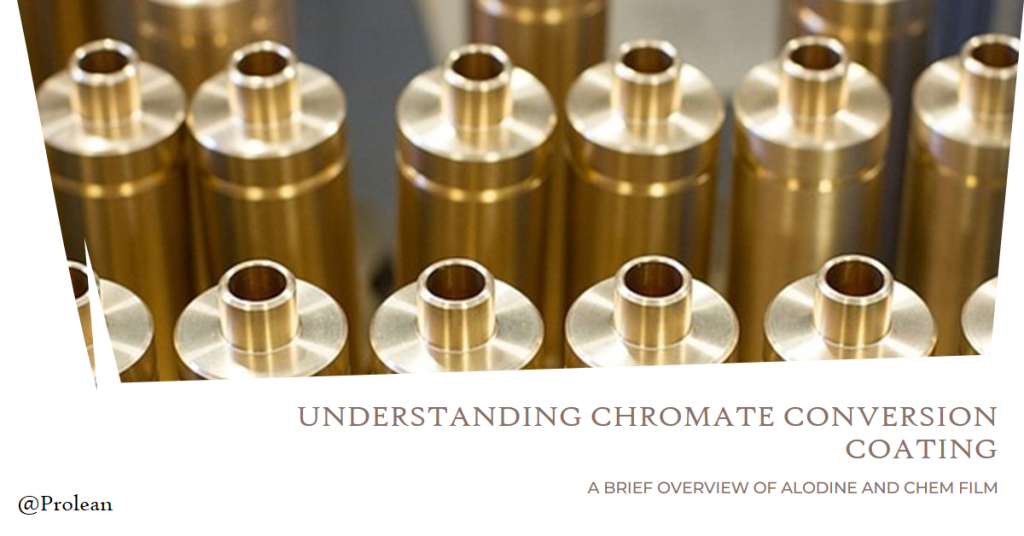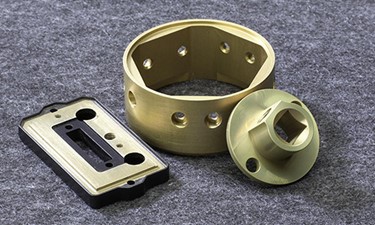“Chromate conversion coating also known as alodine coating or Chem film, it is a type of conversion coating used to passivate aluminum, in some cases, steel, zinc, cadmium, copper, silver, titanium, magnesium, and tin alloys are also applicable. The passivation process creates a protective film on the surface of the properties, which protects it from corrosion.”

Unlike anodizing, chromate conversion coating is a chemical conversion coating. In the chemical conversion coating, a chemical reaction occurs on the surface of the metal, and this chemical reaction converts the metal surface into a protective layer.
The conversion coating itself is not electrically conductive when applied according to Class 3 of the MIL-DTL-5541 standard. Class 3 chemical conversion coatings protect against corrosion where low electrical resistance is required. In this case, the coating itself is also non-conductive, but because the conversion coating gets thinner, it provides a certain level of electrical conductivity。 You can contact our engineers for more information on this.
Fundamentals of the Chromate Conversion Coating

Chromate coatings are the most widely used coating for corrosion protection of Aluminum and Aluminum alloys minimizing surface oxidation. It is commonly used as an undercoat for paint or adhesive applications due to the excellent bonding properties it provides.
Chromate conversion coatings are commonly applied to items such as screws, hardware, and tools. They usually impart a distinctively iridescent, greenish-yellow color to otherwise white or gray metals.

Types/standards and specifications
|
MIL-C-5541E SPECIFICATIONS |
||
| Chromate Classes | • Class 1A- (Yellow) For maximum protection against corrosion, painted or unpainted. • Class 3- (Clear or Yellow) For protection against corrosion where low electrical resistance is required. |
|
|
MIL-DTL-5541F/MIL-DTL-81706B SPECIFICATIONS |
||
| Chromate Classes* | • Class 1A- (Yellow) For maximum protection against corrosion, painted or unpainted. • Class 3- (Clear or Yellow) For protection against corrosion where low electrical resistance is required. |
*Type I- Compositions containing hexavalent Chromium; Type II- Compositions containing no hexavalent Chromium |
|
ASTM B 449-93 (2004) SPECIFICATIONS |
||
| Chromate Classes | • Class 1- Yellow to Brown, Maximum corrosion resistance generally used as final finish • Class 2- Colorless to yellow, Moderate corrosion resistance, used as a paint base and for bonding to rubber • Class 3- Colorless, Decorative, slight corrosion resistance, low electrical contact resistance • Class 4- Light green to green, Moderate corrosion resistance, used as a paint base and for bonding to rubber (Not done at AST) |
|
| Electrical Resistance (Class 3 Coatings) | < 5,000 micro ohms per square inch as applied 10,000 micro ohms per square inch after 168 hours of salt spray exposure |
|
| Chromate Conversion Coating Advantages | Base for Paints, Adhesives, and Powder Coatings Corrosion Resistance Easy to Repair Flexibility Low Electrical Resistance Minimal Build-up |
|
Try Prolean Now!
Chromate Conversion Coating Has Many Benefits & Applications
In addition to enhanced corrosion protection, there are many practical benefits to using chem film coatings including:
- Ideal primer to help paints, adhesives, and other organic topcoats adhere
- Prevent fingerprinting of soft metals
- Quick and easy application by immersion, spray, or brush
- Fewer steps than most chemical processes thus economical and cost-efficient
- Provide reliable electrical connection between parts
- Thin coating, nearly immeasurable, so does not change part dimensions
While most often associated with coating aluminum, chromate conversion coatings can also be applied to cadmium, copper, magnesium, silver, titanium, and zinc.
Which industries can benefit from using chemical film coating?
- Automotive: Heat sinks, Automotive wheels
- Aerospace: Aircraft hulls, Side and torsion struts, Shock absorbers, Landing gear, Parts of the flight control system (the rudder system, wing portions, etc.)
- Building & Architecture
- Electrical
- Marine
- Military & Defense
- Manufacturing
- Sporting & Consumer Goods
Read More:
- Brushing Finish: Steps, Application, Advantages, Disadvantages, and Affecting Factors
- Machining Threads: Everything You Need to Know
- Safety and Effectiveness in Metal Welding: Six Key Considerations
- CNC Lathe Techniques: Tips, Tricks, and Insights
- Types of Washers: Features, Uses, and Applications
Summing Up
Surface finishing holds functional as well as aesthetic importance for industrial parts. With the industries advancing quickly, the tolerance requirements are becoming tighter, and hence better surface finish is required for high-precision products. Parts with appealing looks enjoy a significant advantage in the market. Aesthetic outer surface finishing can make a big difference in a part’s marketing performance.
Prolean Tech’s surface finishing services offer the standard as well as popular surface finishes for parts. Our CNC machines and other surface finishing technologies are capable of achieving tight tolerances and high-quality, uniform surfaces for all kinds of parts. Simply upload your CAD file for a quick, free quote and consultation on related services.




0 Comments